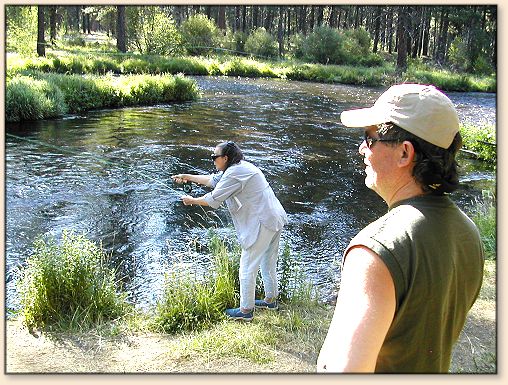|
My personal fishing preference is dry fly on
moving water. Yes, we fish other methods but
if there is a choice I really love seeing a
fish take the fly on top. Upstream and dry.
When you really enjoy a fishing method, you probably
work a little harder at figuring out the things
necessary to make it work. In time, (don't ask how
long, it varies) you know what works. It isn't a
matter of having to check the water flow speed,
where the fish are, which fly, leader length and
type, what kind of a cast - slack line, curve cast
or whatever.
Instead of having to work through each part, you
shift into automatic and make the cast...because
you can. Experience is the key. The difference
between driving a stick-shift and an automatic
transmission.
This became evident at the Central Oregon Fish-In
when Al Roberts, (who is a terrific saltwater and
lake fly fisher) asked for some help with stream
fishing. The fish were picky, they've been fished
to by everyone, so I knew it wasn't going to be easy.
Al had tied a nice stonefly, it was on his rod, and
he challenged me (nicely) to catch the fish they knew
was in a particular pool.
The catch was I had to explain what I was doing and why.
So we walked upstream a short way and he and a couple
of the other guys who had been fishing this pool
explained where the fish were. After trying to
catch one without success, they had gone a bit
upstream and floated some Cheeto's over the pool.
They marked where three fish laid.

The river runs from left to right, a fast riffle
with a pool at the base of the riffle. The fish lay,
one close to the bank, one in the middle and one at
the shoot at the right hand-side of the riffle.
I chose to cast first to the fish on the right,
hoping if I hooked it I could move it out of the
pool and not spook the rest of the fish above it.
I should mention I had mentally figured out where
the fish would try to go, and how to best manage
it. That should be part of your thinking before
you cast or hook one.
The fast water was at the end of the cast, so I made
a slack-line upstream cast and immediately threw some
slack upstream with my rod tip. The float was good
and the fish rose to take the fly on the first cast.
I missed it. Turns out I can't talk and focus on the
fly at the same time. My fault, but the lesson was
a good one. The first cast CAN take the fish, and
probably should. The changes of a hook-up go
downhill from there.
I cast next to the middle fish. No rise. Ditto on
the one next to the bank. I did manage to snag a
branch from an underwater snag at the top of the
riffle. (No, of course that never happens to me.)
But obviously I was trying to get my cast as close
to the bank as I could.
We waited a few minutes, and moved about 20 feet closer.
Several casts and no fish.
The attempts from farther downstream were actually
better because of weeds and bank-side growth to help
hide us from the fish. I was fishing from the bank
and not wading, (actually it was too bloody hot to
be in neoprene waders anyway,) so I could have used
a side-arm cast as well as a normal over-head cast.
The longer cast, accuracy, mend and float (drift)
were the keys to getting the fish to rise. The
fact I didn't catch it was my fault. I don't
believe moving closer would have worked if it
was my first cast, stealth, especially in this
situation was very important.
A final thought; the stonefly I used did have an
orange body - and who knows, maybe the fish took
it as a Cheeto! ~ The LadyFisher

If you would like to comment on this or any other article please feel free to
post your views on the FAOL Bulletin Board!
|





